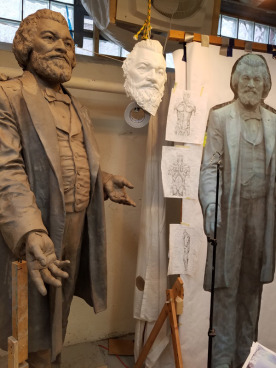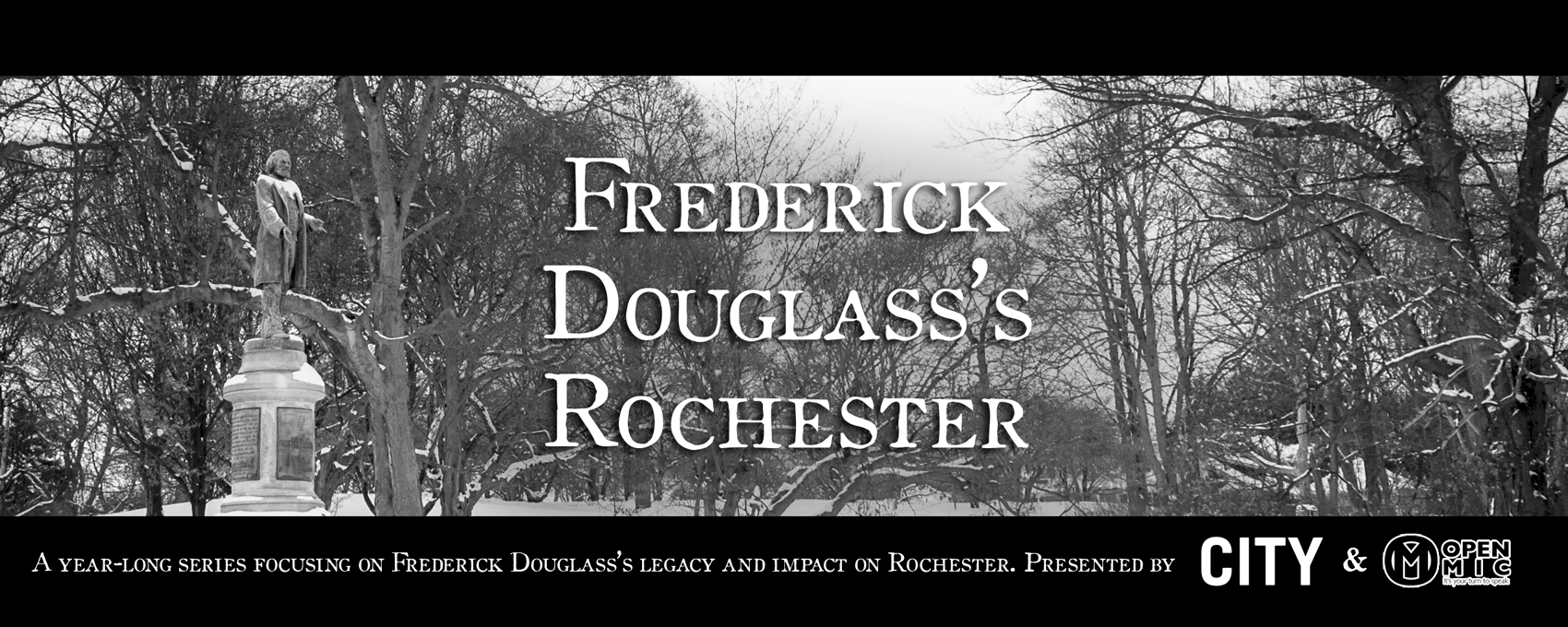By Jake Clapp
Frederick Douglass lived and worked in Rochester for 25 years, walking the streets, frequenting local businesses, and talking with neighbors. The fact of his presence will always be a part of Rochester, and now a set of life-sized statues will bring his physical representation to contemporary city streets.
The statues, and an accompanying “Discover Douglass” self-guided tour, are a project of “Re-Energizing the Legacy of Frederick Douglass,” a multi-organization initiative to commemorate Douglass’s life during the 200th anniversary of his chosen birthdate.
Thirteen statues will be installed beginning July 19, in locations significant to Douglass’s life. The first three will go up on July 19 at Hochstein School of Music and Dance, at the newly named Anna Murray Douglass Academy on South Avenue, and at the Talman Building (25 East Main Street) downtown, where Douglass operated his newspaper office. The remaining statues will be installed over the next few weeks, organizers say. There’ll be an unveiling celebration at 10 a.m. on Thursday at Hochstein.
The statues are part commemoration and part history lesson, and each one will feature a QR code through which people can access information about Douglass and the location on a smartphone. But Carvin Eison, project director for “Re-Energizing the Legacy,” says he also hopes the statues will start a conversation about Douglass’s relevance today.
“We talk about what Frederick Douglass and others of his generation stood for, what they thought about when Rochester was a hotbed of abolitionists and social justice activity,” Eison says. “And we’re interested in that historical aspect, but we’re very interested in thinking, ‘What does Frederick Douglass mean now? What does Frederick Douglass mean going forward?’”

The 6-foot, 7-inch-tall statues — Douglass was over 6 feet tall and there’s a 5-inch base — were created by Rochester artist Olivia Kim and are based on the Sidney Edwards-designed statue at the upper edge of the Highland Park Bowl. That monument originally stood downtown at Central Avenue and St. Paul Street, and one of the replicas will be installed there.
The statues are made out of cast epoxy resin, and plans are to have them in place for around three years.
Douglass’s son Charles served as the model for the original monument, and that intimate family handprint continues: Douglass’s great-great-great-grandson, Kenneth Morris Jr., sat for Kim’s statue. Since Douglass is bearded, Kim asked Morris to pose so that she could better understand the facial structure underneath the beard. She also incorporated a casting of Morris’s hands.
Kim says she studied pictures of Douglass in the archives of the University of Rochester. “I looked at the progression of his facial expression and his body language over the course of all the years he was sitting for photos,” Kim says. She thought about how Douglass had changed and “how this sculpture had to capture his life and the expression of his life.”
“The original sculpture has more of a stately feel to it — he’s speaking to the people,” Kim says. “But I wanted to tweak the pose of this so that you can really feel that within himself, Frederick has compassion for himself. He’s an example of what it is to know one’s self, to know one’s self-worth. When you know your self-worth, you know the worth of other people.”
At least 50 people volunteered to help construct the first three statues, Kim says. And volunteers are still being sought to help with the remaining 10. For more information, contact Michelle Long at michelle.christen@gmail.com.
Information about the statues and the self-guided tour can be found at douglasstour.com. Look below for the full list of planned statue locations.

Also: A marathon reading of Douglass’s first autobiography, “Narrative of the Life of Frederick Douglass,” will take place Thursday through Sunday at locations around Rochester. All can participate, and each student reader will receive a copy of the book (while supplies last).
The reading will take place Thursday, July 19, 12 p.m. to 2 p.m., at Central Library (115 South Avenue); Friday, July 20, 10 a.m. to 2 p.m., at UR’s Rush Rhees Library; Friday, July 20, 2 p.m. to 4 p.m., at the Douglass Community Library (971 South Avenue); Saturday, July 21, 12 p.m. to 2 p.m., at Phillis Wheatley Community Library (33 Dr. Samuel McCree Way); and Sunday, July 22, 1:30 p.m. to 3:30 p.m., at Brighton Memorial Library (2300 Elmwood Avenue).
Planned statue locations:
- School 12: Anna Murray Douglass Academy (999 South Avenue). The site of the Douglass family’s home for 20 years.
- Hochstein School of Music and Dance (50 North Plymouth Avenue). Before it became Hochstein, the site was the Central Presbyterian Church, where Douglass’s funeral was held.
- Talman Building (25 East Main Street). Douglass operated his newspaper in the downtown building.
- 42 Favor Street. The original location for Memorial AME Zion Church, where the Douglass family were members. The church was also important in the area’s Underground Railroad history, and it’s said that Douglass published the first copies of The North Star here.
- Central Avenue and St. Paul Street. The original location for the Sidney Edwards-designed monument to Frederick Douglass. The statue, the first in the United States dedicated to an African-American citizen, was erected near the New York Central Railroad Station on June 9, 1899. “To place a monument of an African-American in front of the train station, so all the world could see that Rochester’s greatest citizen was not a white man, that has to tell you everything you need to know about the impact he had on culture,” Carvin Eison has said in the past.
- Corinthian Street at State Street. The location of Corinthian Hall, Rochester’s premier lecture venue. Douglass delivered numerous speeches there, including his “What to the Slave is the Fourth of July?”
- Alexander Street near East Avenue. The site of the first Douglass family home in Rochester. The family lived there from 1848 to 1852 before building a farm on South Avenue.
- Alexander Street and Tracy Street. Seward’s Seminary stood at this location. Douglass enrolled his oldest daughter, Rosetta, in the school, but soon learned she was made to take classes apart from the other students. The students were willing to have Rosetta join them, but one parent objected – Douglass later called him out in The North Star as “the miserable dough-face who edits the Cass paper in this city” – and Douglass withdrew his daughter from the school.
- Kelsey’s Landing in Maplewood Park (89 Maplewood Drive). This was an important departure point for the Underground Railroad.
- Mt. Hope Cemetery. Douglass is interred here alongside his first wife, Anna Murray, and second wife, Helen Pitts, and youngest daughter, Annie. Rosetta Douglass is also buried in Mt. Hope.
- Washington Square Park. Douglass gave lectures in the park, and he and President Benjamin Harrison spoke in 1892 at the dedication of the Soldiers and Sailors Monument.
- Rochester Educational Opportunity Center (161 Chestnut Street)
- University of Rochester’s Rush Rhees Library, Rare Books and Special Collections

